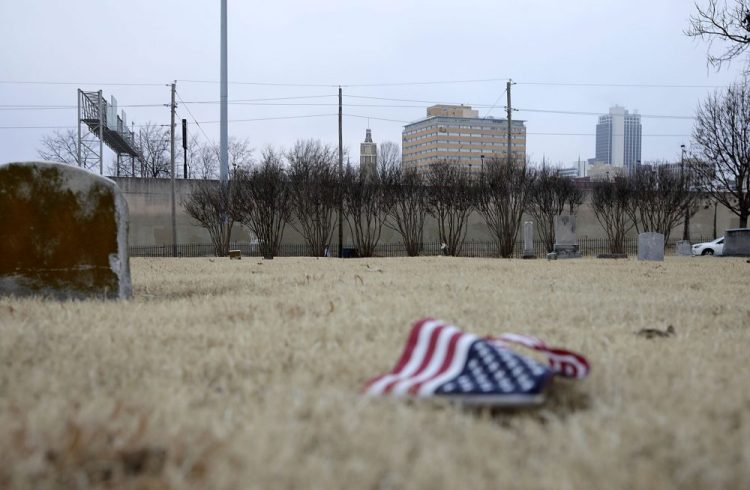TULSA, Okla. – Nearly a century after a race massacre left as many as 300 people dead, the city of Tulsa plans to dig for suspected mass graves that may have been used to dispose of African American bodies.
Archaeologists searching for mass graves connected to the 1921 Tulsa Race Massacre agreed Monday night that Tulsa will conduct “limited excavations” in a city-owned cemetery to determine whether a “large anomaly” detected by ground-penetrating radar contains human remains.
“We do not propose to exhume any human remains during this phase of the investigation,” the committee of archaeologists and forensic anthropologists said. “However, any human remains that are uncovered during the excavation will be treated respectfully and with reverence.”
The excavation is set to begin in April.
The decision comes two months after forensic archaeologists, led by the Oklahoma Archaeological Survey at the University of Oklahoma, revealed that they had found “possible common graves” at two sites in Tulsa. They identified the sites as the Canes, located on a bluff along the Arkansas River near Highway 75, and the Sexton area of Oaklawn Cemetery, which is a few blocks from Greenwood, the black community that was destroyed during one of the worst episodes of racial violence in U.S. history.
Although the scientists said the radar findings were promising, the only way to determine precisely what lies beneath the ground is to dig. The initial excavation will be conducted at Oaklawn Cemetery.
Scientists said they will proceed carefully, so as not to disturb nearby marked graves. They plan to use machines to remove only the top layers of soil. The rest of the excavation will be done by hand, conducted by a team of forensic anthropologists and archaeologists. Each bucket of earth will be screened through a mesh and sifted.
If they find burials that scientists determine are “not associated with a violent event, excavations will be adjusted to leave them in place.” But “if the remains appear to have been associated with another criminal event, they will be further investigated by law enforcement and the Office of the Chief Medical Examiner.”
The determination of the cause of death is a crucial step in the investigation, city officials said.
Kary Stackelbeck, state archaeologist for Oklahoma, said the limited excavation will seek to answer: “Do we have remains consistent with race massacre victims or another event such as the Spanish flu epidemic that occurred in 1919?”
The Mass Graves Public Oversight Committee – made up of descendants of massacre victims, community leaders, historians and scholars – would decide on next steps, city officials said, “as it relates to storing remains, DNA testing and genealogical research, and commemorating the grave sites and honoring the remains.”
The city is still in negotiations with the owner of the third site, Rolling Oaks Memorial Gardens, to allow radar scanning.
The proposal to dig for mass graves comes more than 20 years after renowned forensic anthropologist Clyde Snow found anomalies with “all the characteristics of a dug pit or trench,” the Tulsa Race Riot Commission wrote in its 2001 report.
The commission, created by the Oklahoma legislature in 1997 to establish a historical record of the massacre, recommended “a limited physical investigation . . . to clarify whether it indeed represents a mass grave.”
But the investigation was closed without a physical study of the sites.
The massacre began May 31, 1921, when a white mob marched on Tulsa’s Greenwood neighborhood, one of the most affluent black communities in the country. It was often referred to as “Negro Wall Street” and later “Black Wall Street.”
The mob gathered after a black teenager, who was working as a shoe shiner in downtown Tulsa, was arrested and accused of assaulting a white woman “on a public elevator in broad daylight,” according to the 2001 commission report.
There was a fight between “angry white vigilantes gathered at the courthouse intent on lynching the shine boy” and armed black men intent on protecting him, according to the report. A shot was fired, and the violence began.
Historians believe as many as 300 black people were killed in the massacre, and much of Greenwood was leveled by fire. The destruction included more than 1,250 homes, churches, schools, businesses, a hospital and a library.
Survivors reported that bodies were tossed into the Arkansas River or loaded onto trains, making it difficult to account for the dead.
In 2018, Tulsa Mayor G.T. Bynum, a Republican, announced that he would reopen the investigation into mass graves, calling it a murder investigation. The announcement followed a Washington Post story about unresolved questions surrounding the massacre.
Bynum said the city is obligated to find out what happened in 1921 as Tulsa prepares to mark the 100th anniversary of the massacre. “We owe it to the community to determine if there are mass graves in our city,” Bynum told The Post. “We owe it to the victims and their family members.”
Copy the Story LinkComments are not available on this story.
Send questions/comments to the editors.


